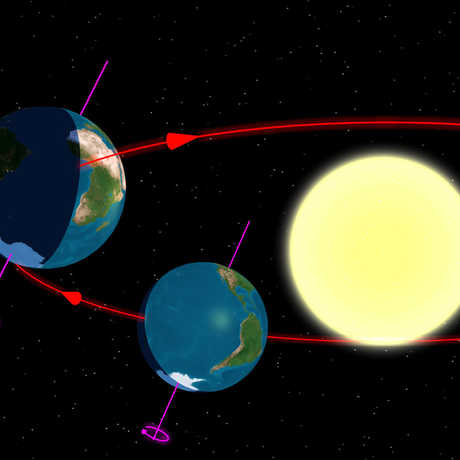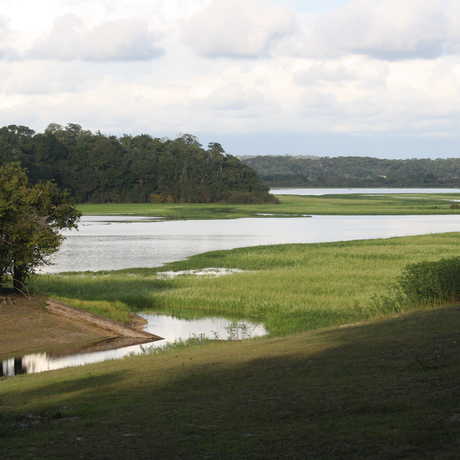In this kinesthetic model, students will learn that plants need carbon dioxide, water, and sunlight to carry out photosynthesis. Using ping pong balls and egg cartons, they will simulate the production of sugar molecules to store energy (photosynthesis), and then break apart these molecules to acquire energy (cellular respiration). This active simulation makes it easier to remember both processes!
Through this kinesthetic model, students will learn:
- that plants need carbon dioxide, water, and sunlight to carry out photosynthesis.
- that photosynthesis produces sugar molecules that store energy.
- that plants and animals can use that energy after breaking apart the sugar molecules through cellular respiration.
- that plants exchange gasses through the stomata and land vertebrates exchange gasses through the lungs.
- egg cartons (6 per group)
- ping-pong balls (36 per group)
- “energy tokens” (24 per group)
- three signs, one that says “stomata”, one that says “stem”, and one that says “lungs”
- (optional) Travel Deep Inside a Leaf video to set the stage
Teacher Tip: Gathering and preparing these materials will be time-consuming the first time you do the activity. However, all of the materials can easily be stored and reused year after year.
- Determine how many groups you will have. Each group will need 4 – 6 students. (If you are short on supplies, groups as large as 8 students could work.) You will need 36 ping-pong balls, 24 energy tokens, and 6 egg cartons for each group.
- Prepare ping-pong balls. These will represent carbon, hydrogen, and oxygen atoms. Use a sharpie to label the ping-pong balls. For each group of students, you will need 6 balls labeled “C”, 12 balls labeled “H”, and 18 balls labeled “O.”
- Collect egg cartons. These will be used to structure the molecules that students will be constructing. (Ask students to bring in egg cartons from home for a few weeks before the activity to help collect enough.) You will need 6 egg cartons for each group.
- Prepare the egg cartons. Cut the egg cartons apart into the shapes shown in the attached document. These shapes will “frame” the molecules that students will assemble. Label the inside of each compartment to show what atom should be placed in it. Note that the shapes of the O2, CO2 and H2O frames are roughly accurate; however, the shape of the sugar molecule is greatly simplified. Each group needs 6 CO2 frames, 6 O2 frames, 6 H2O frames, and 1 sugar frame.
- Prepare “energy tokens.” These should be small squares of paper or cardstock (about 2 inches by 2 inches is ideal). Each group of students will need at least 24 energy tokens. Prepare them for the simulation start by folding in half to represent “light energy.”
- Post signs in the classroom. These label areas for the simulation. The door will be the “STOMATA” and the sink (or a place of your choice) will be the “STEM”.
- Prepare filled H20 and C02 “molecules.” As you describe the simulation to your students, you’ll place the water near the sink, the carbon dioxide in the hallway, and the empty oxygen frames in the hallway, too.
Your Task: Build a sugar molecule in a leaf cell!
Consider using the Travel Deep Inside a Leaf video to "set the stage" for what the classroom looks like.
- Review (or introduce) the term photosynthesis. This is the process that plants use to get energy (whereas humans and other animals get energy by eating food). Through photosynthesis, plants create sugar molecules that store energy for them to use later. Some of the sugar molecules become part of the structure of the plant in the form of cellulose.
- Have students discuss with a partner what they think plants need in order to do photosynthesis. Let them brainstorm ideas, then tell them they will discover this through the activity.
- Review (or introduce) the concept of stomata, which are small openings on the underside of the leaf. When the stomata are open, air can move in and out of the leaf. When they are closed, the inside of the leaf is sealed off from the outside air.
- If appropriate for your students, review the difference between atoms and molecules. An atom is the smallest possible piece of a pure substance, like carbon or hydrogen. A molecule is made of two or more atoms bonded together.
Explain that the classroom will represent a leaf, and that each table within the classroom will represent a cell within the leaf. Students will be working in groups to build a sugar molecule in their cell.
- Give each group an empty sugar frame. Look at labels in the frame. Review what atom each letter represents. (C = carbon. H = hydrogen. O = oxygen.)
- Tell students the carbon atoms will be coming from carbon dioxide molecules (CO2). Where is CO2 found? (In the air.) How does CO2 gets into the leaf? (CO2 in the air enters the leaf through the stomata.) Tell students that the classroom represents the leaf and the area outside the room represents the air surrounding the leaf. Open the door and place filled CO2 molecules just outside.
- The hydrogen atoms will be coming from water molecules (H2O). How does water get into the leaf? (It is drawn from the soil into the roots, up the stem, and into the leaf.) Place the filled H2O molecules under the sign.
- Some of the oxygen atoms will come from CO2 molecules and some from H2O molecules.
- Show students the energy tokens. Explain that sugar molecules store energy. To represent this, students will have to pack an energy token under each atom in the sugar frame. Ask students where the leaves get this energy. (From sunlight.) However, the energy in light is not in a form that can be used by a plant. Show students the folded energy tokens. Folded in a rectangle, they represent “light energy” from the sun. Folded in a triangle, they represent “chemical energy” that they plant can use. Explain that plants convert energy from one form to another so that it can be stored in sugar molecules. Act as the sun and will sprinkle the “light energy” tokens around the room.
- Students will have to work together within their groups to gather the things they need and put the sugar molecule together. Teacher Tip: You can decide whether to assign a role to each student or to let the groups work out the process on their own.
- Actions:
- Sugar molecule must be completed. As the materials are gathered, take atoms from the CO2 and H2O molecules and place them in the appropriate places in the sugar frame.
- Carbon dioxide molecules must be carried to the cell. Bring CO2 molecules from the outside area to the table.
- Water must also be carried to the cell. Bring these molecules from the sink to the table.
- You have to get rid of empty frames. Put them where they belong!
- Energy must be collected and converted into a usable form. Gather energy tokens to the table and convert them from “light energy” into “chemical energy.” Pack an energy token under each atom in the sugar molecule. This represents the energy stored in the bonds within a sugar molecule.
- Atoms cannot be wasted. When you take apart a molecule, take all the atoms out of the frame. For example, you can’t take the hydrogen out of the water frame and leave the oxygens in. Without the hydrogen, it’s not a water molecule anymore.
- Leftover atoms go from the cell to the air. At the end of the activity, the only thing students should have on their table is the completed sugar molecules. Any leftover materials need to be taken out of the leaf and expelled into the air.
- Only fetch one thing at a time.
- You can split up the tasks, but STILL only one thing at a time!
Once students are clear on what to do and where to find the materials, have them start building sugar molecules.
Teacher Tip: Now is a good time to put the empty 02 molecule containers in the hallway.
After the simulation, discuss some of these questions:
- What did the plant need to do photosynthesis? (Carbon dioxide, water, and light energy)
- Where did it get those things? (Carbon dioxide from the air outside the leaf, water taken up from the soil, and light energy from the sun)
- Where did the oxygen come from? Where do it go? (Oxygen was leftover after the carbon and hydrogen had been used from the CO2 and water; the oxygen went out through the stomata into the air)
- Is the air outside the cell any different than it was before? (After photosynthesis, the air contains less CO2 and more oxygen)
If desired, you can emphasize the ingredients that are needed for photosynthesis by repeating the activity with limited access to the different components. This also highlights some ways that plants can be affected by the environment.
In each scenario, start by putting all materials back in their original starting places. Tell students the scenario, remove access to one resource, and let them try to produce a sugar molecule. They will soon realize they can’t do it without light/ CO2 / H2O. Ask students why this is so.
Round 2: Take away all the energy tokens. Tell the students the sun has gone down and no light is available. They must try to produce a sugar molecule without light, while still following all the rules. Do they think it’s possible? [Try -> fail -> discuss!]
Round 3: Close the door. Tell students the stomata have closed and no air is able to enter or exit the leaf. They must try to produce a sugar molecule with no air. [Try -> fail -> discuss!]
Round 4: Remove all the water molecules from the stem area. Tell students there is a drought and there is no water for the plant to take up from the soil. They must try to produce a sugar molecule without water. [Try -> fail -> discuss!]
Your Task: Find something cells need to break down sugar, so we can use energy from our sugar molecule!
- Let’s use some of the energy that they stored in their sugar molecules.
- Tell students that when cells break down sugar to access energy, they release CO2 and water. However, there is a piece missing—they need to get something in addition to sugar to make this happen. Their task is to discover what that is and how to get it.
- Give groups empty CO2 and H2O frames. Tell them success is achieved when these molecules are complete and released in to the air as byproducts.
- Give them time to break apart the sugar molecule, remove the energy tokens, and try to make the CO2 and H2O molecules. Leave the door (stomata) open and the oxygen atoms from earlier outside.
- Students will find that they need oxygen in order to complete the molecules, and should figure out that they can get it from the “air” outside the leaf.
- The CO2 and H2O molecules should then be taken out the stomata (released into the air.)
- Reassemble the sugar molecules for this round and put all materials back in their starting places.
- Explain that animal cells need energy, and also get it by breaking apart sugar molecules. BUT animal cells can’t make their own sugars the way plant cells can. So where do animals get the sugar they need? (By eating plants.)
- Tell students that the leaf they are a part of is about to be swallowed by a hungry herbivore. The leaf is getting chewed up and digested. Then the sugar molecules that were contained within the leaf are passed to cells in the body.
- Take down the “stomata” sign and the “stem” sign. Tell students that the classroom now represents the animal’s body. Each table is a cell within the animal. The cells need to break apart the sugars to release energy so the animal has can use it to keep moving around. Just like in plants, the process will release CO2 and water. What are they missing to make this happen? (Oxygen.) Where will the animal get that oxygen? (By breathing it in.) Put a new sign over the door that says “lungs.”
- Now go through the respiration process again. This will be the very same process as it was for plants—the only difference is that oxygen enters through the lungs instead of the stomata. Students should bring oxygen in through the lungs (door) and release the CO2 and H2O produced in the process out through the lungs.
- If desired, discuss the terms respiration and cellular respiration. This can be confusing since they refer to different but related processes.
- The task students were doing at the tables—breaking apart sugar to release energy—is called cellular respiration. It’s a metabolic process—essentially a chemical reaction.
- The task of bringing O2, CO2, and H2O molecules to and from the cell is called respiration. It’s not a chemical reaction, it’s simply the exchange of gasses (CO2, H2O, O2, etc.) between cells and the environment.
- The process of cellular respiration is exactly the same in plants and in animals.
- The process of respiration differs between plants and animals. In plants, gas is exchanged passively through the stomata. In land-dwelling vertebrates (like humans), gas is exchanged actively through the lungs. (Other animals have other methods, like gills, tracheoles, etc.)
Photosynthesis is an essential process in plants. Through this process, energy from light is converted into a form that can be used by the plant. The energy is stored in sugar molecules. Animals (including humans) are not able to make this conversion, so we depend on plants to provide energy in a form that our bodies can use.
Plants take in water through the roots and carbon dioxide (CO2) through the stomata. A pigment called chlorophyll, found in green parts of the plant such as leaves and green stems, captures energy from the sun. All three of these components—water, CO2, and light—are required in order for photosynthesis to occur. Oxygen is produced as a waste product.
Cellular respiration is also an essential process, and takes place in all living things. Through this process, large molecules, such as the sugar molecules produced by photosynthesis, are broken down so that the energy stored within them can be used by the organism. Oxygen is required in order for this to occur, and CO2 and water are produced as waste products.
Since both plants and animals do cellular respiration, they both need to take in oxygen from the air and release CO2 and water into the air. In plants, this occurs through the stomata. In land vertebrates (like humans) this happens through the lungs. (Other animals have other methods, like gills, tracheoles, etc.)
In this activity, students will act out both processes (photosynthesis and cellular respiration), providing a tangible illustration of what components are needed for each process, as well as what the waste products are.
Disciplinary Core Ideas
Grade Five
- LS1.C: Organization for Matter and Energy Flow in Organisms
- PS3.D: Energy in Chemical Processes and Everyday Life
Middle School
- LS1.C: Organization for Matter and Energy Flow in Organisms
- PS3.D: Energy in Chemical Processes and Everyday Life
High School
- LS1.C: Organization for Matter and Energy Flow in Organisms
Science and Engineering Practices
- Using Models
Crosscutting Concepts
- Systems and System Models
- Energy and Matter
Performance Expectations
5-PS3-1. Use models to describe that energy in animals’ food (used for body repair, growth, motion, and to maintain body warmth) was once energy from the sun.
MS-LS1-6. Construct a scientific explanation based on evidence for the role of photosynthesis in the cycling of matter and flow of energy into and out of organisms.
HS-LS1-5. Use a model to illustrate how photosynthesis transforms light energy into stored chemical energy.




